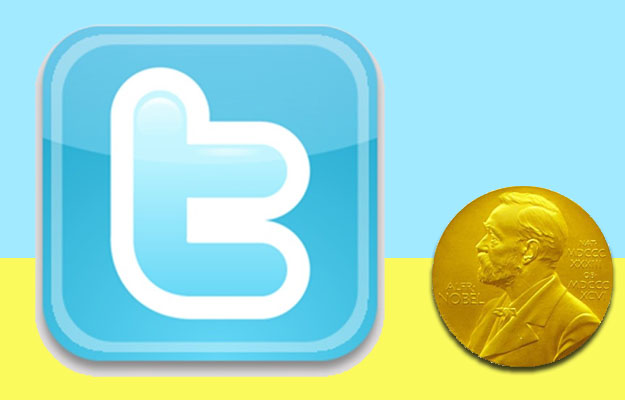
Is Twitter worthy of a Nobel Peace Prize or is it just plain fluff?
I was speaking with a exec friend the other day and he told me: “I feel like I’m routinely having two sets of conversations–one with people that understand the game-changing power of (social) networks and another set with people that think the world is the same as it was five years ago.” I feel that same thing. And it turns out we’re not the only two.
Former National Security Adviser Mark Pfeifle wrote a piece called “A Nobel Peace Prize for Twitter?” He paints a picture of a world with and without tools like Twitter, tools that amplify a cause… that enable social change. I understand that it’s hard for us to even fathom the question in the title of his piece, and yet that’s exactly what he’s asking us to do. Why would we NOT assign massive accolades to any person, service or tool that enabled individuals to get their voice heard in places like Iran and China? Why would we NOT promote those things even more if they enable people to organize and further move their idea forward?
On the flip side, Malcolm Gladwell wrote “Small change, why the revolution will not be tweeted.” His case is that Twitter is too light of a touch and it doesn’t offer a deep enough connection. A revolution, or even a movement, cannot be fostered 140 characters at a time. He references the deep connection people made with the Civil Rights movement and essentially suggests Twitter is no match for the fever that accompanied people’s connection to that cause at the time.
Two interesting perspectives. And while it would be easy to say the truth is somewhere in-between, I think there are other elements to this question in the title of this blog. Here’s my take:
1. Twitter is a tool, leverage its strengths.
Like all tools, Twitter has some unique characteristics which contribute to its strength. Twitter is extremely portable (140 characters, all alphanumeric, super-fast, launchable and readable from many different places/platforms/devices). It enables net new access to people beyond your current sphere. This goes far past the ability to follow (insert celebrity of the moment). Think of the smartest person you know. See if they are on Twitter and look at who they are following. Keep going up that ladder and you’ll find access to people I’m guessing you never thought you could get close to. Now you can read what they suggest you read. The inverse is true as well, people can follow you or your brand.
2. Twitter isn’t a panacea, no tool is. Compliment it with other tools.
Most people wouldn’t screw in a screw in with a hammer. Similarly, most people would see value in screwing in lots of screws with a cordless drill. Why would someone spend 45 seconds to drive in a single screw by hand when they can do the same thing in 3 seconds? This is where I have large challenges seeing Gladwell’s side. Twitter is one tool in a quiver of tools. By itself it may not enable a revolution or a movement, but as part of a dynamic mix of modern tools, I see it as worthy today and potentially more relevant tomorrow as its functionality evolves.
3. Leverage a tool’s full functionality.
You’d never compete in a race by driving a car in only the first and second gears. For a similar reason sending a message out on Twitter without a hashtag is like leaving horsepower on the table. All tools have an evolving set of functionality; learn them so you can employ it towards a goal. Watch what is trending, and make the list work to your advantage.
4.If you only want to drive awareness, use wide, light-touch tool-sets.
If you’re just trying to get people’s attention, perhaps offer an ephemeral connection with your message then use tools that do only this. Historically you might look at billboards. Today there are a myriad of tool options (web ads, search, etc). I would argue that Twitter isn’t one of these tools, as it requires too much up front work to connect to a person/idea. A person must first follow you and second read your message (potentially clicking on a link in your message, third). If a person does these things then they’re already beyond awareness and at the beginning stages of connectedness.
5. If a deep connection is the goal, drive people down a funnel of increased engagement with a myriad of tools.
At Surfrider Foundation we know we start with a blank slate. We need to attract people and find some way for them to make a lightweight, low-friction connection. This may be connecting on Facebook to an employee or volunteer or maybe one of our Facebook pages. Only once we’ve gained some trust and credibility can we then ask for the next level of engagement, maybe suggesting they subscribe to the weekly newsletter. After that we seek to connect people to local chapters, then participation in local campaigns, then leadership, etc.
6. Expect all tools to live and die with increasingly smaller lifespans.
Facebook isn’t the first social network and it won’t be the last. Same goes for Twitter as a messaging platform. Understand that all tools have a lifespan, most are short and others are a bit longer. Few things live for decades without some kind of large-scale morph. Always be on the lookout for a new tool that will drive higher returns.
Read more from Jim Moriarty on his Ocean, Waves, and Beaches Blog.

